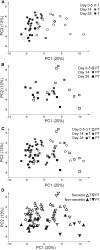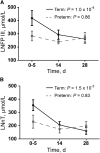Infant Maturity at Birth Reveals Minor Differences in the Maternal Milk Metabolome in the First Month of Lactation
- PMID: 26041675
- PMCID: PMC4516766
- DOI: 10.3945/jn.115.210252
Infant Maturity at Birth Reveals Minor Differences in the Maternal Milk Metabolome in the First Month of Lactation
Abstract
Background: Human milk is the gold standard of nutrition for infants, providing both protective and essential nutrients. Although much is known about milk from mothers giving birth to term infants, less is known about milk from mothers giving birth to premature infants. In addition, little is known about the composition and diversity of small molecules in these milks and how they change over the first month of lactation.
Objective: The objective was to understand how milk metabolites vary over the first month of lactation in mothers giving birth to term and preterm infants.
Methods: (1)H nuclear magnetic resonance (NMR) metabolomics was used to characterize metabolites that were present in micromolar to molar concentrations in colostrum (day 0-5 postpartum), transition milk (day 14), and mature milk (day 28) from mothers who delivered term (n = 15) and preterm (n = 13) infants. Principal components analysis, linear mixed-effects models (LMMs), and linear models (LMs) were used to explore the relation between infant maturity and the postpartum day of collection of milk samples.
Results: By using a standard NMR metabolite library, 69 metabolites were identified in the milks, including 15 sugars, 23 amino acids and derivatives, 11 energy-related metabolites, 10 fatty acid-associated metabolites, 3 nucleotides and derivatives, 2 vitamins, and 5 bacteria-associated metabolites. Many metabolite concentrations followed a similar progression over time in both term and preterm milks, with more biological variation in metabolite concentrations in preterm milk. However, although lacto-N-neotetraose (LMM, P = 4.0 × 10(-5)) and lysine (LM, P = 1.5 × 10(-4)) significantly decreased in concentration in term milk over time, they did not significantly change in preterm milk.
Conclusion: Overall, the metabolic profile of human milk is dynamic throughout the first month of lactation, with more variability in preterm than in term milk and subtle differences in some metabolite concentrations. This trial was registered at clinicaltrials.gov as NCT01841268.
Keywords: human milk; human milk oligosaccharides; lactation; metabolomics; preterm; term.
© 2015 American Society for Nutrition.
Conflict of interest statement
Author disclosures: AR Spevacek, JT Smilowitz, EL Chin, MA Underwood, JB German, and CM Slupsky, no conflicts of interest.
Figures



References
-
- Eidelman AI, Schanler RJ, Johnston M, Landers S, Noble L, Szucs K, Viehmann L, Feldman-Winter L, Lawrence R, Kim S, et al. . Breastfeeding and the use of human milk. Pediatrics 2012;129:e827–41. - PubMed
-
- Anderson GH. The effect of prematurity on milk composition and its physiological basis. Fed Proc 1984;43:2438–42. - PubMed
-
- Gabrielli O, Zampini L, Galeazzi T, Padella L, Santoro L, Peila C, Giuliani F, Bertino E, Fabris C, Coppa GV. Preterm milk oligosaccharides during the first month of lactation. Pediatrics 2011;128(6):e1520–31. - PubMed
-
- Gross SJ, Geller J, Tomarelli RM. Composition of breast milk from mothers of preterm infants. Pediatrics 1981;68:490–3. - PubMed
Publication types
MeSH terms
Substances
Associated data
Grants and funding
LinkOut - more resources
Full Text Sources
Other Literature Sources
Medical

